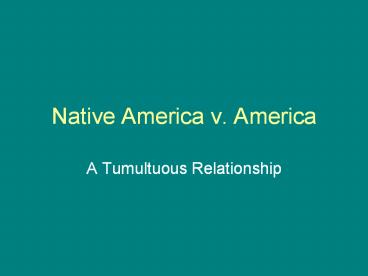Native America v. America - PowerPoint PPT Presentation
1 / 29
Title:
Native America v. America
Description:
Native America v. America A Tumultuous Relationship I. Three categorizations: American view of American Indians As Neighbors As Landowners As citizens II. – PowerPoint PPT presentation
Number of Views:260
Avg rating:3.0/5.0
Title: Native America v. America
1
Native America v. America
- A Tumultuous Relationship
2
I. Three categorizations
3
II. As Neighbors Encounter Exchange
The Good Exchange of crops, animals,
farming The Bad Importation of disease and
violence
4
Relationship with Colonizers
- Spanish were Conquistadores who created
encomiendas - French needed help with the fur trade
- English came to settle, at first were friendly
5
The English American Indians
- As the English colonist moved west, wars broke
out in the 1600s
6
The American Revolution
- 13,000 American Indian warriors fought on the
British side - Americans resented tribal help to Brits
7
c. Noble Savages
- Others saw them as needing to be civilized
including people like Thomas Jefferson
8
d. Post-War Fighting
- Indian raids on white settlements
- Whites used raids as an excuse to ravage Indian
villages in the late 1700 and early 1800s
9
e. Assimilation1880s-1940s
- return to idea that Indians are civilizable
- Offshoot of Progressive era
- Kill the Indian, save the Man
10
f. Indian Boarding Schools
- creation of Indian boarding schools
- No language
- No traditions
- No families
- Sent out to white families on breaks to work as
servants
11
g. Conservation of Culture1935-1950
- Indian New Deal
- Romanticization of American Indian culture
- Many stereotypes still prevalent
12
h. American Indian Movement 1970s
- Grew out of Civil Rights Movement of 1960s
- reclamation of tribal land
- Much more forceful than other movements
- 75 takeovers of federal buildings or land
(including Alcatraz)
13
1973 Pine Ridge (Wounded Knee-site of 1890
massacre)
- Protest over treaty rights and stripmining
- National Guard surrounded area cutting off access
- daily gunfire between occupiers and troops2 men
killed - 71 days in length
- govt arrested 1200 at end
- followed by controversial arrests and deaths of
prominent Nat Am leaders
14
III. As Landowners
- Go West, Young Man!
- Westward movement of settlers creates tensions
with Native American tribes
15
b. French and Indian WarStuck in the Middle
with You
- As the English moved west toward the Ohio and
Mississippi Rivers, the French became worried
they would lose access to the fur trade - Both colonizers built forts in the mid-1700s
- The American Indians were caught in the middle
most tribes sided with the French - War ends with treaty, followed by Proclamation of
1763
16
d. Land in the New Republic
- In the late 1700s the Iroquois, Choctaws,
Cherokee, Creek, Chickasaws all signed treaties
with government ceding giving up land - Some tribes resisted
- Tribes left with small independent nations
17
e. Indian Removalunder President
Jackson1830-1839
18
f. Black Hawk War (1831-32)
- Sauk and Fox Indians in IL
- whites very viciousattacked even when Black Hawk
tried to surrender - led to slaughter and removal
19
g. Trail of Tears Cherokees
- 1,000 fled to North Carolina
- Winter of 1838 rest began march to Indian
Territory - about ¼ died
20
h. The Far West
- Plains tribes concentrated into 2 territories
Oklahoma (Indian Territory) and the Dakotas - allowed government to take most desirable land
and separate Indians physically and politically - management given to Bureau of Indian
Affairscompletely corrupt
21
i. Destruction of Buffalo
- partly to feed all westward migrants
- partly to feed fashion
- partly to clear way for railroads
- partly for amusement
- 1875 virtually extinct (15 mil 1865)
22
j. Resistance the End of Indian Wars
- Continual fighting from 1850s-1880s
- Govt would no longer negotiate with chiefs
- surrendered in 1886official end of fighting
betweens whites and Indians - Was 1890 Wounded Knee massacre of Lakota Sioux
Geronimo
23
As Citizens The Constitution
- Addressed Native Americans
- excluded native americans not taxed from pop.
count for representation - gave Congress power to negotiate treaties with
tribes trade with tribes - legal standing very unclearbig issue as time
went on
24
In the Courts 1830s
- Chief Justice John Marshall made 3 major
decisions in Supreme Court cases that helped to
clarify political status of Native Americans - Only government could buy or take land from
Native Americans-reservations are still entrusted
to US govt - Federal Govt is the guardian of tribes-no need
for separate courts - Indian reservations are not always subject to
state law
25
The Dawes Act 1887
- gradual elimination of tribal ownership of land
- force assimilation to white model of society
- tribal land reduced from 155 mil acres to 48 mil
acres by 1934
26
Citizenship Granted
- Inconsistent citizenship
- by marrying white men
- through military service
- by allotments
- 1924 Indian Citizenship Act
27
New Deal for Indians1933-1945
- 1933 created Indian Emergency Conservation
Program (IECP) - employed 85,000 Nat Am
- 1934 Indian Reorganization Act
- ended Dawes Act
- provided for tribes to buy new land
- recognized tribal constitutions
- federal grants to provide social services
- prohibitions on language, religion and custom
lifted
28
Modern Day Relations 1970-present
- 1950s Termination Era
- Attempt to reduce government involvement
- Return to assimilation
- Tried to repay tribes for lands taken illegally
- 1970 to present Self-Determination
- Native American tribes are semi-autonomous
- Independent governments
- federal govt in role of protector to allow for
self-government
29
(No Transcript)































